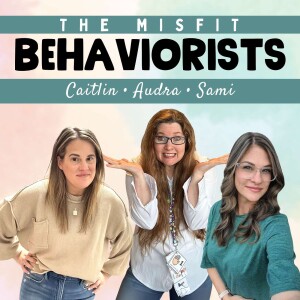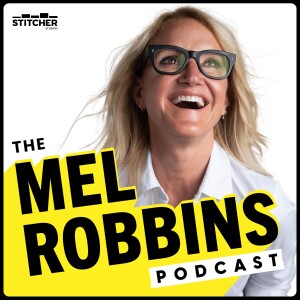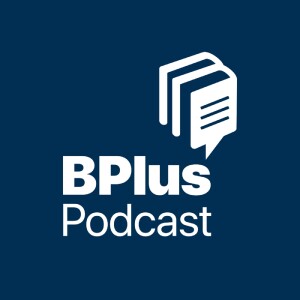

The Misfit Behaviorists - Practical Strategies for Special Education and ABA Professionals
https://rss.buzzsprout.com/2299007.rssEpisode List

Ep. 67: The Role of a BCBA on RTI & MTSS Teams in Schools
Being a BCBA in a public school means more than behavior plans—it’s about collaboration, data, and supporting teachers on RTI and MTSS teams. In this episode, we share tips for building relationships, starting with Tier 1 strategies, and making sure your role feels valuable (not overwhelming!) to your general education colleagues.🔑 Key Takeaways• Start simple: Review Tier 1 supports before jumping to FBAs or complex plans.• Bring tools: Have ready-to-use data sheets and low-prep interventions for teachers.• Collaborate first: Ask teachers what’s already working and build from there.• Show, don’t tell: Bring visual examples like token boards or contracts to spark ideas.• Build trust: Celebrate teacher wins and keep follow-ups short, consistent, and encouraging.📦 Resources & Links• Free Tier 1 Interventions Checklist → https://abainschool.com/tier1• Related Episodes: Ep. 58 Bridging the Gap → https://abainschool.com/ep58 and Ep. 14 Life as a School Based BCBA guest → https://abainschool.com/ep14🤝 Join Us💬 Share how you support RTI/MTSS teams in the Misfit Behaviors Facebook Group → https://abainschool.com/misfits🌟 Subscribe: Don’t miss future episodes with practical BCBA strategies → https://www.youtube.com/@themisfitbehaviorists📢 Share this episode with your RTI team, BCBA colleagues, or administrators to spark collaboration and support!Join the Facebook group for collaboration and freebies: The Misfit Behaviorists😍 More, you say? We’re here for you! Apple podcast | The Misfit Behaviorists Instagram | @themisfitbehaviorists YouTube | @themisfitbehaviorists 👋 Find us! Audra | ABA in School Caitlin | Beltran’s Behavior Basics Sami | B.A.S.S. 🖱️ Rate, Review, Like & Subscribe so you don’t miss an episode! Showing this love helps us get out to more educators out there!

Misfit Minute 13: Reduce Student Pushback with Simple Choice Strategies in Special Education
Offering students simple choices can reduce pushback and boost cooperation. In this Misfit Minute, we break down how to turn everyday directives into opportunities for autonomy and engagement.🔑 Key TakeawaysChoice = Power: Even small choices give students autonomy and reduce resistanceCircle Time Example: Let students choose where or how they sit instead of forcing one optionDirective Reframe: Switch “Put your things away and line up” to “Do you want to line up first or pack up first?”Weekly Challenge: Rewrite one classroom directive as a choice that works for you and your students📦 Resources MentionedRelated episodes: Pre-Correcting Behavior → http://abainschool.com/mm7 and FBA Miniseries on Antecedent Strategies → https://abainschool.com/ep51Free classroom tools & resources inside the Misfit Behaviors Facebook Group → https://abainschool.com/misfits🙌 Join Us & ShareJoin the conversation in our Facebook group → https://abainschool.com/misfitsSubscribe so you don’t miss future Misfit Minutes and full-length strategy episodesShare this episode with a teammate who needs proactive classroom strategies!Join the Facebook group for collaboration and freebies: The Misfit Behaviorists😍 More, you say? We’re here for you! Apple podcast | The Misfit Behaviorists Instagram | @themisfitbehaviorists YouTube | @themisfitbehaviorists 👋 Find us! Audra | ABA in School Caitlin | Beltran’s Behavior Basics Sami | B.A.S.S. 🖱️ Rate, Review, Like & Subscribe so you don’t miss an episode! Showing this love helps us get out to more educators out there!

Ep. 66: Behavior Management for Early Learners - 5 Preschool Classroom Strategies
Teaching little ones with big feelings can be equal parts joyful and challenging. In this episode, we share five simple, effective strategies for supporting early learners in preschool and special education settings. From using visuals to keeping it playful, you’ll walk away with practical tools you can try tomorrow.🔑 Key Takeaways• Keep it visual: Use simple schedules, choice boards, and social stories to support communication and independence.• Narrate everything: Model positive language with calm, playful tones (think Mr. Rogers or Miss Rachel style).• Prevention matters: Catch behaviors early with pre-corrections, sensory breaks, and proactive supports.• Repetition is key: Expect to teach skills 50+ times—consistency builds mastery.• Play is better than lecture: Embed learning into games, role play, and parallel play for lasting impact.📦 Resources & Links• Related Episodes: Episode #64 Preschool Circle Time Episode #18 Behavior Management Basics • If you need some preschool circle time ideas, check these out! 🤝 Join Us 💬 Let us know your favorite data collection tip in the Misfit Behaviors Facebook Group 🌟 Subscribe: Don’t miss upcoming episodes on practical strategies and must-have resources for behavior support! 📢 Share this episode with a teacher, BCBA, or administrator looking for fresh approaches to special education and behavior analysis! 💬 Let us know what YOU wanna talk about in our Facebook group Join the Facebook group for collaboration and freebies: The Misfit Behaviorists😍 More, you say? We’re here for you! Apple podcast | The Misfit Behaviorists Instagram | @themisfitbehaviorists YouTube | @themisfitbehaviorists 👋 Find us! Audra | ABA in School Caitlin | Beltran’s Behavior Basics Sami | B.A.S.S. 🖱️ Rate, Review, Like & Subscribe so you don’t miss an episode! Showing this love helps us get out to more educators out there!

Misfit Minute 12: Spot Early Warning Signs to Prevent Escalation in the Classroom
This week’s Misfit Minute is all about catching behaviors before they escalate. Caitlin breaks down how to spot the earliest warning signs—like a shift in posture or a sigh—and why waiting until the meltdown starts is already too late. Learn how small, proactive strategies can prevent big challenges in the classroom.🔑 Key TakeawaysEscalation is the “tip of the iceberg” — behaviors begin long before yelling or refusal.Early signs might include subtle changes like silence, avoidance, or body language.Use antecedent strategies such as offering choices, adjusting tasks, or modifying the environment.Proactive support reduces the likelihood of major problem behaviors.Reflection matters: ask, “What could I have done a few minutes earlier?”📦 Resources MentionedRelated episode: FBA Miniseries on Antecedent Strategies Free classroom tools & resources inside the Misfit Behaviorists Facebook Group 🙌 Join Us & ShareJoin the conversation in our Facebook group Subscribe so you don’t miss future Misfit Minutes and full-length strategy episodesShare this episode with a teammate who needs proactive classroom strategies!Join the Facebook group for collaboration and freebies: The Misfit Behaviorists😍 More, you say? We’re here for you! Apple podcast | The Misfit Behaviorists Instagram | @themisfitbehaviorists YouTube | @themisfitbehaviorists 👋 Find us! Audra | ABA in School Caitlin | Beltran’s Behavior Basics Sami | B.A.S.S. 🖱️ Rate, Review, Like & Subscribe so you don’t miss an episode! Showing this love helps us get out to more educators out there!

Ep. 65: How to Teach Maintenance and Generalization of Skills in ABA and Special Education
If it’s not generalizing, it’s not functional. In this episode, we break down what true mastery looks like, how to plan for maintenance from the start, and practical ways to “teach loosely” so skills stick across people, places, and materials.🔑 Key TakeawaysRedefine Mastery: Ditch “80% for 3 days” as the finish line—probe across time (weeks), people, places, and materials.Plan for M+G Early: Write IEP goals that embed generalization (different staff, tables, exemplars) and maintenance checks.Teach Loosely ≠ Teach Sloppily: Use multiple exemplars (sizes, fonts, colors), varied instructions, and rotate staff from day one.Schedule Maintenance: Build in review times (e.g., Friday maintenance, quick sweeps after work sessions) and intersperse mastered items.Use Natural Opportunities: Count lunch boxes, read names on cubbies—teach outside the data squares for real-life use.Team Communication Wins: Share what works across classroom, gym, lunch, recess; align prompts and exemplars.Match the Learner: Some learners need tight scaffolds; others generalize quickly—individualize criteria and pacing.🧰 Strategies You Can Use TomorrowGoal Writing Upgrades: “Match letters with different colored cards, at different tables, with different staff, across two weeks at 80%.”Exemplar Rule of 3: Teach each concept with ≥3 versions (e.g., tiger photos, clipart, figurine).Mastered Bin System: Keep a “M” bin of mastered targets to intermix with new learning.Quick Maintenance Routines: 3–5 min daily spot-checks; Friday review block.Motivate Naturally: Embed practice before preferred activities (recess, lunch) for built-in reinforcement.📦 Resources & LinksRelated Episodes: Episode #16 Probe vs Trial-by-Trial data and Episode #5 DTT vs NET🤝 Join Us 💬 Let us know your favorite data collection tip in the Misfit Behaviors Facebook Group 🌟 Subscribe: Don’t miss upcoming episodes on practical strategies and must-have resources for behavior support! 📢 Share this episode with a teacher, BCBA, or administrator looking for fresh approaches to special education and behavior analysis! 💬 Let us know what YOU wanna talk about in our Facebook group Join the Facebook group for collaboration and freebies: The Misfit Behaviorists😍 More, you say? We’re here for you! Apple podcast | The Misfit Behaviorists Instagram | @themisfitbehaviorists YouTube | @themisfitbehaviorists 👋 Find us! Audra | ABA in School Caitlin | Beltran’s Behavior Basics Sami | B.A.S.S. 🖱️ Rate, Review, Like & Subscribe so you don’t miss an episode! Showing this love helps us get out to more educators out there!
You may also like
Create Your Podcast In Minutes
- Full-featured podcast site
- Unlimited storage and bandwidth
- Comprehensive podcast stats
- Distribute to Apple Podcasts, Spotify, and more
- Make money with your podcast












